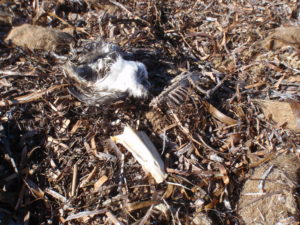A piece of bone that I found whilst walking on Largs North beach this month has been identified as being from a Little Penguin.
I took a couple of photos of the bone, which I first thought could have been shark cartilage. I posted some of these photos on Facebook, seeking identification of the creature that the bone may have come from. My photos created an interesting debate on Facebook. The end result though, was that the bone was thought to have come from a Little Penguin, Eudyptula minor.
According to Wikipedia, “The little penguin (Eudyptula minor) is the smallest species of penguin. It grows to an average of 33 cm in height and 43 cm in length”. Because of their small size, they are often called fairy penguins.
During the Facebook debate regarding my bone photographs, I learnt that: –
“All birds have a keel. In other creatures, we would call it a breast-bone. The shape depends on whether the bird needs to fly a lot, and how, or whether it mostly swims or walks.”
“Emus and possibly some other flightless birds lack a keel.”
“The flight muscles attach to the keel, so flightless birds don’t need one.”
“The bone attached is fairly flat, so I’m guessing (and it is a guess) that it’s a bird that does some swimming/floating.”
“This looks like the sternum of a bird (= carina, when it has a keel.) The broad / highest part of the keel is towards the head end. In a couple of the pix, you can see where the ribs were attached.”
“chicken breast bones (sternum) is often cartilaginous especially in the carineal area.”
“it would seem that the extended breast bones indicate that it is from a diving bird like a penguin or shearwater. Those who are interested can read more and see examples at http://www.shearwater.nl/index.php?file=kop125.php .” (The web page there reads “Breastbone or sternum – The breastbone or sternum is one of the largest bones of a bird’s skeleton and is part of pectoral girdle. It consists of a convex/concave basal plate and the keel perpendicular to it, protruding ventrally.”
“The extended nature of the breast bones suggests that it is a bird that dives, but not a shearwater.”
“It actually looks more like a penguin than anything else. Can only find a few pics of gulls but they don’t match, although a gull would seem way more likely than a penguin, however it does look a lot like the penguin sternum pictured in the link.”
“The flat bits (near the metasternum) look like the processus lateralis. The coracoids come off the end where the keel is biggest, near the apex cristae sterni, in those crinkly areas just north of where the ribs join.”
“I’m drawing parallels to a rockhopper penguin. Size seems about right, and it’s not like any flying bird sternums I’m aware of.”
At about this stage, I received news from Dr Philippa Horton, Senior Collection Manager, Ornithology at the South Australian Museum, saying: –
“Hi Steve, it’s a sternum from a penguin, hard to judge what size it is but almost certainly from a Little Penguin. If it is about 9-10 cm long, then definitely a Little Penguin.”
My response to Philippa was, “That’s great, I guess. Not so great for the penguin though. Do you require such samples at all? Thanks for your help.”
Philippa’s reply was, “No, we don’t need this particular bone as Little Penguins are well represented from Gulf St Vincent in our collection, but other seabirds (except Short-tailed Shearwaters) and any of the larger penguins are definitely worth keeping if ever you find any, thank you.”
My thanks go to Philippa Horton and all of my Facebook friends for their assistance in this matter.
The SA Natureteers Facebook group ended up using my penguin bone photo as a header for their Facebook page for a little while. I found a couple more bones on a subsequent trip to the beach, and took these photos: –
Now I have more mysteries to solve!






